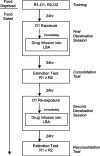Consolidation and reconsolidation of incentive learning in the amygdala - PubMed (original) (raw)
Consolidation and reconsolidation of incentive learning in the amygdala
Szu-Han Wang et al. J Neurosci. 2005.
Abstract
Incentive learning is the process via which animals update changes in the value of rewards. Current evidence suggests that, for food rewards in rats, this learning process involves the amygdala. However, it remains unclear whether this learning undergoes protein synthesis-dependent consolidation and "reconsolidation" processes in the lateral and basal nuclei of amygdala. Accordingly, we examined this hypothesis by local infusion of protein-synthesis inhibitor after devaluation of a food reward induced by a shift from a food-deprived to a food-sated state in an instrumental conditioning paradigm. Our results show that intra-amygdala infusions of anisomycin, whether given after the initial devaluation or after a second devaluation session, abolished the changes in the value of the food reward produced by incentive learning. This study provides direct evidence that instrumental incentive learning depends on protein synthesis within the amygdala for both consolidation and reconsolidation and extends the demonstrations of protein synthesis-dependent reconsolidation to reward-related memories.
Figures
Figure 1.
Flow chart of the behavioral procedures used. For details, see Materials and Methods.
Figure 3.
A, Summary of group designs. B, Test 1. Inhibition of protein synthesis during consolidation (ANI) impairs the differential responding controlled by the outcome value displayed by the VEH group. C, Test 2. Inhibition of protein synthesis during reconsolidation (ANI) impairs differential responding controlled by outcome value displayed by the VEH group. Choice performance is indicated by the responses (mean ± SEM) made on either the devalued (R1) or nondevalued (R2) lever.
Figure 2.
Location of cannula tips in the LBA for groups V/A (▵) and A/V (•). The first and last letters in the group names refer to the drug treatments (vehicle or anisomycin) received after the first or second devaluation session, respectively. The number under each section denotes its position relative to bregma (in millimeters), according to the atlas of Paxinos and Watson (1998).
Figure 4.
Anisomycin impairs consolidation (left) and reconsolidation (right) of incentive learning. Choice performance is represented as the mean percentage of total responses (±1 SEM) made on each lever after either vehicle or anisomycin treatment. The data are plotted separately for the two tests and for both group V/A and group A/V. See Results for details.
Similar articles
- Fear memories require protein synthesis in the amygdala for reconsolidation after retrieval.
Nader K, Schafe GE, Le Doux JE. Nader K, et al. Nature. 2000 Aug 17;406(6797):722-6. doi: 10.1038/35021052. Nature. 2000. PMID: 10963596 - Involvement of amygdaloid protein synthesis in early- and late-phase reconsolidation of emotion-related memories.
Chuang JY, Lin KY, Cherng CG, Yu L. Chuang JY, et al. Chin J Physiol. 2012 Oct 31;55(5):314-22. doi: 10.4077/CJP.2012.BAA068. Chin J Physiol. 2012. PMID: 23282205 - Linking new information to a reactivated memory requires consolidation and not reconsolidation mechanisms.
Tronel S, Milekic MH, Alberini CM. Tronel S, et al. PLoS Biol. 2005 Sep;3(9):e293. doi: 10.1371/journal.pbio.0030293. Epub 2005 Aug 23. PLoS Biol. 2005. PMID: 16104829 Free PMC article. - Goal-directed instrumental action: contingency and incentive learning and their cortical substrates.
Balleine BW, Dickinson A. Balleine BW, et al. Neuropharmacology. 1998 Apr-May;37(4-5):407-19. doi: 10.1016/s0028-3908(98)00033-1. Neuropharmacology. 1998. PMID: 9704982 Review. - Reward expectation alters learning and memory: the impact of the amygdala on appetitive-driven behaviors.
Savage LM, Ramos RL. Savage LM, et al. Behav Brain Res. 2009 Mar 2;198(1):1-12. doi: 10.1016/j.bbr.2008.10.028. Epub 2008 Oct 31. Behav Brain Res. 2009. PMID: 19022299 Free PMC article. Review.
Cited by
- Offline orbitofrontal cortex reactivation depends on recency of place-reward changes and coheres with hippocampal replay.
Rusu SI, Bos JJ, Marchesi P, Lankelma JV, Ferreira Pica I, Gentet LJ, Joëls M, Pennartz C. Rusu SI, et al. iScience. 2024 Feb 10;27(3):109205. doi: 10.1016/j.isci.2024.109205. eCollection 2024 Mar 15. iScience. 2024. PMID: 38482496 Free PMC article. - Preventing fear return in humans: Music-based intervention during reactivation-extinction paradigm.
Verma A, Mitra S, Khamaj A, Kant V, Asthana MK. Verma A, et al. PLoS One. 2024 Feb 21;19(2):e0293880. doi: 10.1371/journal.pone.0293880. eCollection 2024. PLoS One. 2024. PMID: 38381711 Free PMC article. Clinical Trial. - Temporal prediction error triggers amygdala-dependent memory updating in appetitive operant conditioning in rats.
Tavares TF, Bueno JLO, Doyère V. Tavares TF, et al. Front Behav Neurosci. 2023 Jan 10;16:1060587. doi: 10.3389/fnbeh.2022.1060587. eCollection 2022. Front Behav Neurosci. 2023. PMID: 36703723 Free PMC article. - Memory Modulation Via Non-invasive Brain Stimulation: Status, Perspectives, and Ethical Issues.
Farina M, Lavazza A. Farina M, et al. Front Hum Neurosci. 2022 Mar 4;16:826862. doi: 10.3389/fnhum.2022.826862. eCollection 2022. Front Hum Neurosci. 2022. PMID: 35308617 Free PMC article. - Chronic Distress in Male Mice Impairs Motivation Compromising Both Effort and Reward Processing With Altered Anterior Insular Cortex and Basolateral Amygdala Neural Activation.
Cabeza L, Ramadan B, Cramoisy S, Houdayer C, Haffen E, Risold PY, Fellmann D, Peterschmitt Y. Cabeza L, et al. Front Behav Neurosci. 2021 Sep 13;15:717701. doi: 10.3389/fnbeh.2021.717701. eCollection 2021. Front Behav Neurosci. 2021. PMID: 34588963 Free PMC article.
References
- Balleine BW (2001) Incentive processes in instrumental conditioning. In: Handbook of contemporary learning theories (Mowrer RR, Klein SB, eds), pp 307-366. Mahwah, NJ: Erlbaum.
- Balleine BW, Dickinson A (1998) Goal-directed instrumental action: contingency and incentive learning and their cortical substrates. Neuropharmacology 37: 407-419. - PubMed
- Berman DE, Dudai Y (2001) Memory extinction, learning anew, and learning the new: dissociations in the molecular machinery of learning in cortex. Science 291: 2417-2419. - PubMed
Publication types
MeSH terms
Substances
LinkOut - more resources
Full Text Sources



